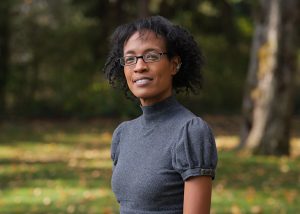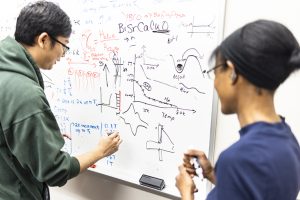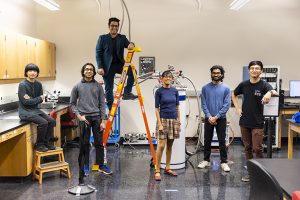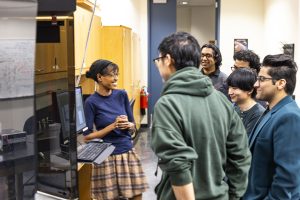By Wayne Gillam / UW ECE News

UW ECE Assistant Professor Serena Eley studies superconductors and magnets, searching for ways to fine-tune the atomic disorder landscape in these materials and leverage their unique properties for quantum technology development. Photo by Ryan Hoover / UW ECE
Imperfection and disorder are part of life. This is true, not only on the level of everyday reality with which we are most familiar, but also within all matter at the smallest scales imaginable. At the nanoscale, ordered atomic lattices that make up solid-state materials contain impurities, dislocations, bends, and vacancies in their grids. And in some materials important to engineering, such as superconductors and magnets, this disorder can actually be useful, for example, helping scientists and engineers control the motion of a nanoscale whirlpool of electrical current called a “quantum vortex.” Superconductors and magnets can host a multitude of these tiny vortices, which can be thought of as mini-tornadoes of electrical current or electron spins, swirling around, interacting with, and disrupting electrical currents within the materials.
UW ECE Assistant Professor Serena Eley studies these vortices. Her lab, the Eley Quantum Materials Group, examines superconductors and magnets, searching for ways to fine-tune the atomic disorder landscape in these materials and leverage their unique properties for quantum technology development. Her research involves finding ways to control the motion and formation of quantum vortices by optimizing defects in superconductors, work aimed at further enhancing conductivity and reducing energy loss. For example, she was recently part of an international research team that achieved the maximum critical current that has ever been measured in an iron-based superconductor to date, groundbreaking work that was described in the journal Nature Materials. Her research also includes studying defects and a vortex-like excitation in magnets called a “skyrmion.” These quasi-particles are showing promise as information carriers for spintronic devices, which encode information in the spin of an electron. Spintronic devices have proven to be useful in computing, data storage, and even biomedical applications. They also have several advantages over conventional electronics, such as faster switching speeds, higher data storage density, and lower energy consumption.
“We try to increase our fundamental understanding of superconductivity and magnetism in a way that can contribute to a wide range of applications. But when designing superconductors, we also have to consider the impact of vortices,” Eley said. “It affects all these applications. So, when designing the material or the device, we have to think about how to lessen the impact of vortices in some instances and how to maximize their effectiveness in others.”
Superconductors and magnets are already in wide use today — from magnetic resonance imaging, or MRI, scanners that look deep inside the body to gamma ray detectors of clandestine nuclear material to bolometers used in x-ray astronomy. They have been implemented in medical, military, security, and power applications as well as quantum computing and sensing. Because Eley’s research contributes to expanding fundamental knowledge about superconductivity and magnetism, her work could contribute to advancing technology in all of these areas. But her research is primarily aimed at the development of quantum computing systems, which show great promise for facilitating significant breakthroughs in science, medicine, and engineering.
A physicist who is also an engineer

Jiangteng (Ivan) Liu, a UW doctoral student in physics, with Eley in her lab at UW ECE. Liu is drawing a magnetization loop, which describes how the current-carrying capacity of a superconductor varies with an applied magnetic field. Photo by Dennis Wise / University of Washington
Eley became fascinated with superconductivity in elementary school, after reading an article about maglev trains, which use a combination of superconductors and magnets to achieve a stable levitation state. She realized, even at a young age, that she wanted to learn more about superconductivity and magnetism, so she set her mind toward pursuing a career in science. She attended a science and technology high school in Northern Virginia and later went on to Caltech, where she received her bachelor’s degree in physics in 2002. After graduation, she spent a year as a research assistant and a Henry Luce Scholar at the International Superconductivity Technology Center in Tokyo, Japan. She then attended the University of Illinois at Urbana-Champaign, where, in 2012, she earned her doctoral degree in physics.
After graduate school, Eley worked for two years at Sandia National Laboratories designing silicon-based devices composed of quantum dot nanostructures. This was followed by three years as a postdoctoral researcher at the Los Alamos National Laboratory, where she studied vortex dynamics in superconductors. In 2018, she accepted a position as an assistant professor of physics at the Colorado School of Mines. And in January 2023, she joined UW ECE as a tenure-track assistant professor. Eley said she made the move to UW ECE because of the number and caliber of graduate students in the Department as well as access to state-of-the-art facilities, such as those available at the Washington Nanofabrication Facility and the UW Molecular Engineering Materials Center.
“I’m in an electrical engineering department, but I definitely think like a physicist because that’s my background,” Eley said. “In physics, you’re usually trying to develop fundamental knowledge, rather than design a device or a system. But my research has always been forward thinking in terms of exploring how fundamental properties connect to applications, so it ends up working well in an electrical engineering department.”
In addition to the Luce award, Eley received the John Bardeen award at the University of Illinois for her doctoral dissertation, which explored proximity effects and vortex dynamics in nanostructured superconductors. She also has received many other awards and honors, such as a National Science Foundation CAREER Award, a Joseph A. Johnson III Award for Excellence, a Goddard Award for Best Research Contribution at the NASA Academy Goddard Space Flight Center, and a Cottrell Scholars Award.
The Eley Quantum Materials Group

Members of the Eley Quantum Materials Group in Ely’s lab at UW ECE. From left to right: Chris Matsumura, UW doctoral student in physics; Rohin Tangirala, UW ECE doctoral student; Chaman Gupta (on ladder), UW doctoral student in materials science and engineering; UW ECE Assistant Professor Serena Eley; Raahul Potluri (BSEE ‘24), UW ECE post baccalaureate student; Jiangteng (Ivan) Liu, UW doctoral student in physics. Photo by Dennis Wise / University of Washington
Eley’s lab at UW ECE includes undergraduate and graduate students from a range of disciplines, including electrical and computer engineering, physics, and materials science. Her UW collaborators include Jiun-Haw Chu, an associate professor in the physics department, who creates high-quality superconducting and magnetic materials for Eley’s research experiments. Eley is also a faculty member of the Institute for Nano-Engineered Systems and QuantumX at the University.
Eley’s specialty is vortex physics, and the overarching goal of her research is to study the effects of disorder on the electronic and magnetic properties of quantum materials and devices. To this end, she and her research team study vortex dynamics in superconductors, the effects of disorder on skyrmion dynamics in magnetic materials, and energy loss mechanisms in superconducting quantum circuits. Eley is also leading a concerted effort to move toward predictive design in a field that has traditionally relied on trial and error to discover and improve superconducting and magnetic materials.
“In an ideal world, we would be able to improve our understanding of vortex physics enough that we could, based on some basic parameters of the material, design the optimal defect landscape without so much trial and error,” Eley said. “For example, in different superconductors and based on each material’s properties, we want to figure out what the ideal disorder landscape might look like, so we can maximize the current-carrying capacity of the material.”
A dedicated educator

Eley with students, standing next to a magnetometer in her lab. The group is discussing magnetic phases in iron-based superconducting crystals and corresponding effects on the motion of superconducting quantum vortices in the material. Photo by Dennis Wise / University of Washington
Eley teaches undergraduate and graduate-level courses at UW ECE. She has also worked with Department staff members May Lim, director of industry and professional programs, and Rebecca Carlson, career and industry programs manager, to start a UW ECE Industry Mentors program. Many leading companies, such as Boeing, Airbus, Intel, and Rigetti Computing are participating. This effort connects undergraduates with mentors who are working in fields related to the students’ career interests. She noted that students are not usually given this sort of opportunity until they are seniors, at which point it is too late for them to go back and select courses related to their mentorship experience.
“I think it’s important to connect freshman and sophomore-level undergraduates with mentors who are actively working in their goal fields,” Eley said. “These professionals are best positioned to provide students with up-to-date advice on what they should be doing and what courses they should be taking to create a strong academic profile for career goals.”
Eley said that she enjoys teaching and the challenge of explaining complex topics to students. She also has some advice for them. For undergraduates, she recommends that every summer be spent in an internship. This provides opportunities to try out different working environments long before choosing a job. For graduate students, she advises them to focus on one project or research direction and prove their ability by getting results. More specifically, she said it is important for graduate students to demonstrate their technical capabilities, scientific communication skills, and analytical ability (being able to extract the science from their technical accomplishments) before moving on to seek professional development opportunities.
As exemplified by her advice to students, quantum science and engineering is a field that requires rigorous discipline. And Eley is no stranger to a disciplined approach professionally or personally. Outside of the UW, she spends much of her free time training for 100-mile ultramarathons. In 2024, she completed the Hardrock Hundred Mile Endurance Run, which summits multiple 13,000-foot peaks in southern Colorado, and the Ultra-Trail du Mont Blanc in Chamonix, France, which winds its way for 110 miles through France, Switzerland, and Italy. Other notable performances include finishing as the third-fastest female runner in the 2023 Grindstone Trail Running Festival in Virginia’s Allegheny Mountains and the second-fastest female in the 2017 Angeles Crest 100 Mile Endurance Run in the San Gabriel Mountains near Los Angeles.
Running 100-mile races takes grit, determination, and a special kind of love for an uncommon interest. It could be argued that these character traits lend themselves well to quantum science and engineering. Building a successful career in this field also takes a special interest and discipline. It perhaps even benefits from a sense of awe and fascination with the subject matter, much like what Eley has demonstrated since childhood.
“I think I will always be fascinated by superconductivity. I understand the math, but still, it can be hard to fully comprehend,” Eley said. “It’s like flying in an airplane. You may understand the concept of lift and the supporting mathematics. But still, it’s pretty amazing to realize that a plane can fly without falling. That’s how I feel about superconductivity.”
For more information about UW ECE Assistant Professor Serena Eley, her research, and work as an educator, visit her bio page.

